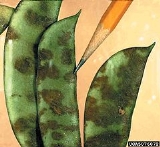
Colletotrichum lindemuthianum
Encyclopedia
Colletotrichum lindemuthianum is a plant pathogen, which causes anthracnose of common bean (Phaseolus vulgaris).
(CATs) before germination from conidia when still is in the plant, in contrast to the genetic model fungus Neurospora crassa
(bread mould) that produces conidial anastomosis tubes from conidia and conidial germ tubes during germination. Other Colletotrichum species produce conidial anastomosis tubes as well. The initial characterization of CATs was made in this plant pathogen in 2003 by Roca et al. in Brazil.
Conidial anastomosis tubes
Colletotrichum lindemuthianum, produces conidial anastomosis tubesConidial anastomosis tubes
Conidial anastomosis tubes are cells formed from the conidia of many filamentous fungi. These cells have a tubular shape and form an anastomosis that allows fusion between conidia....
(CATs) before germination from conidia when still is in the plant, in contrast to the genetic model fungus Neurospora crassa
Neurospora crassa
Neurospora crassa is a type of red bread mold of the phylum Ascomycota. The genus name, meaning "nerve spore" refers to the characteristic striations on the spores. The first published account of this fungus was from an infestation of French bakeries in 1843. N...
(bread mould) that produces conidial anastomosis tubes from conidia and conidial germ tubes during germination. Other Colletotrichum species produce conidial anastomosis tubes as well. The initial characterization of CATs was made in this plant pathogen in 2003 by Roca et al. in Brazil.

